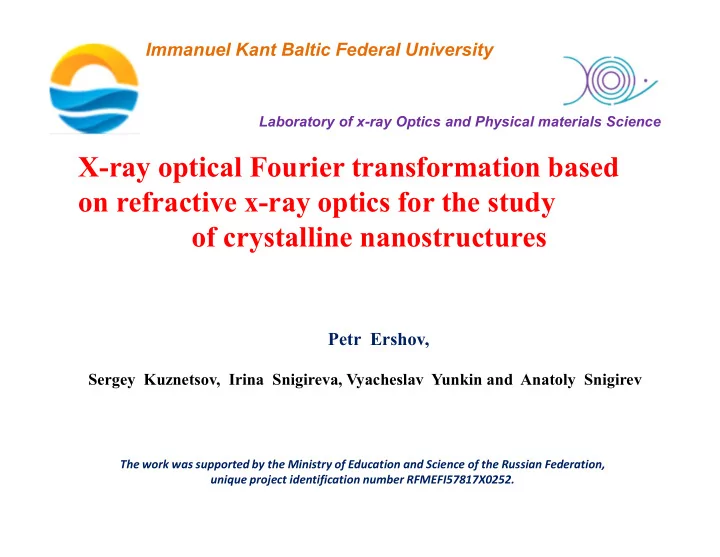

Immanuel Kant Baltic Federal University Laboratory of x-ray Optics and Physical materials Science X-ray optical Fourier transformation based on refractive x-ray optics for the study of crystalline nanostructures Petr Ershov, Sergey Kuznetsov, Irina Snigireva, Vyacheslav Yunkin and Anatoly Snigirev The work was supported by the Ministry of Education and Science of the Russian Federation, unique project identification number RFMEFI57817X0252.
“One of the most remarkable and useful properties of a converging lens is its inherent ability to perform two-dimensional Fourier transforms. This complicated analog operation can be performed with extreme simplicity in a coherent optical system, taking advantage of the basic laws of propagation and diffraction of light. “
Introduction. Concept of the Fourier transform (a) Object placed against the Lens 2 ku A exp j 2 f 2 U ( u ) t ( x ) exp j xu dx j f f The Fourier transform is not a complete one, due to the presence of the quadratic phase factor that precedes the integral. (b) Object placed in front of the Lens 2 ku d A exp j ( 1 ) 2 f f 2 U ( u ) t ( x ) exp j xu dx j f f (c) Object placed behind the Lens 2 ku A exp j 2 d f 2 U ( u ) t ( x ) exp j xu dx j d d d The scale of the Fourier transform depends on the distance d from the focal plane.
Introduction. X-ray Fourier imaging by refractive optics Theoretical calculations In addition to focusing x-ray beams by refractive optics, it is possible to perform a Fourier transformation of the wave front as per visible light with conventional lenses. Experimental observations Fourier images obtained from x- rays transmitted through a photonic crystal.
Introduction. X-ray Fourier imaging by refractive optics Experimental observations on colloidal crystals How it will work for Bragg diffraction of periodic structures? Periodic structure of a Bragg condition Fourier transform by lenses crystal
Experiment ESRF beamline BM5 Distance to source 39 m X-ray wavelength (energy) 0,75 Å (16,5kEv) Lens effective aperture 130 μm Intensity transmission 17,5% Source-size projection 2,7 μm Silicon Bragg reflection (111) Sample: profiled Si Δω = ±9’’ Sample: SiO 2 grating
Object – 2D grating P. Zaumseil and et. al. By Parabolic Compound Refractive Lenses with point focusing we performed 2D Fourier transforms of crystal reciprocal space Period 360 nm Si substrate and Si pillars
Object – 2D grating P. Zaumseil and et. al. By Parabolic Compound Refractive Lenses with point focusing we performed 2D Fourier transforms of crystal reciprocal space Period 360 nm Si substrate and Si pillars
CRL Fourier transform vs CDI To analyze diffraction from Si-Ge nano- heterostructure is more efficient to use CRL, because: - CRL concentrate more x-ray intensity - More area could be analyzed by one shot 1 - CRL perform higher resolution in 1 reciprocal space Normilized int. Normilized int. 0.1 0.1 0.01 0.01 -7.8 -5.2 -2.6 0.0 2.6 5.2 7.8 -7.8 -5.2 -2.6 0.0 2.6 5.2 7.8 -1 ) q (um -1 ) q (um First order maxima First order maxima contrast ~ 93 % contrast ~ 64 % Contrast is higher Resolution ~0.05 um -1 Resolution ~1.5 um -1 Resolution is higher Exposure time = 30 sec Exposure time = 1 sec Exposure is lower
Scanning in reciprocal space. 1 By thetha-2theta scan we 0.1 recorded a reciprocal space Normilized int. 0.01 volume near Si 004 reflection. 1E-3 -100 -50 0 50 100 -1 ) q z (um [001] q z [010] [100]
Si 004 reciprocal space volume Reciprocal space [010] [001] 200 um -1 2.7 um -1 [100] [100] 2.7 um -1 [001] [100] [010] [001] [010] The surface represent reciprocal space near Si 004 [100] reflection. These techniques gives a lot of information about crystals orientation, form factors, !Whole recording time is 1 min! periodicity and perfection in three dimensions.
Ge 004 reciprocal space [001] Si 004 57 um -1 19.2 um -1 [010] [100] 365 um -1 Ge 004 Due to the Germanium dots lattice tilt there are no periodical structure in the reciprocal space. Germanium peak 004 is broad in all directions. 38 um -1
Conclusions • X-ray refractive optics is a powerful wave front analyzer with high angular resolution • As well as studying the sample using the transmitted beam, we could also use the diffracted beam. • Due to Bragg diffraction, we could perform a crystallographical analysis of an object • Fourier transform techniques could be used to design an X-ray diffraction microscope similar to transmission electron microscope where both electron microscope images (information in real space) and diffraction patterns (information in reciprocal space) for the same region can be observed. Part of the x-ray microscope. Experimental hutch, ID06, ESRF, Grenoble, France
Thank for you attention! The work was supported by the Ministry of Education and Science of the Russian Federation, unique project identification number RFMEFI57817X0252.
Recommend
More recommend